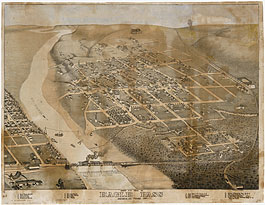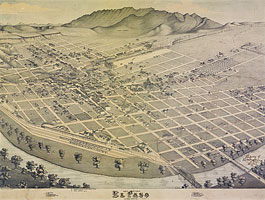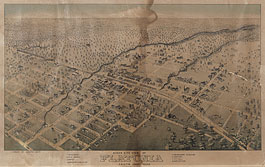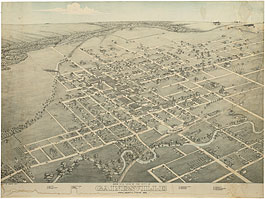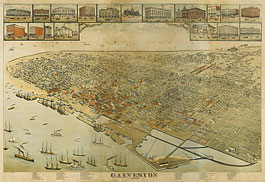Eagle Pass in 1887
Augustus Koch’s bird’s-eye view of Eagle Pass is dominated by the Rio Grande on the left side of the picture; the Galveston, Harrisburg and San Antonio Railway at the right and bottom; and Fort Duncan in the lower right-hand corner. An unnamed creek separates the city from the fort.
Eagle Pass began in 1850 when a settlement grew up around Fort Duncan, which had been established the previous year on… [More]El Paso in 1886
Throughout its history prior to 1881, El Paso-area business had been dominated by its location on the north-south Camino Real that connected Mexico City with Chihuahua and Santa Fe. With the arrival of the Southern Pacific Railroad in May 1881, however, the city got a direct rail connection with the West Coast, and when the Southern Pacific connected with the Texas and Pacific at Sierra Blanca the following December… [More]
Flatonia in 1881
The area around Flatonia was settled by Anglo-Americans prior to the Civil War, but inexpensive land gradually brought German, Bohemian, Greek, Arabian, and Italian immigrants into the region. The city itself was created by the Galveston, Harrisburg and San Antonio Railway as it built west through Fayette County from Schulenburg in April 1874. Residents of old Flatonia, one mile southeast of the new site, and Oso, three miles northeast… [More]
Gainesville in 1883
The Gainesville that Augustus Koch depicted in 1883 was a prosperous cattle town, with a large courthouse and public school building financed by income from the cattle business. The first Anglo-American settlers arrived in the area, on the western border of the Eastern Cross Timbers, where “the magnificent roll of the prairie is broken abruptly off against the woody rim,” in the 1840s, and the city was founded as… [More]
Galveston in 1885
Augustus Koch’s view of Galveston in 1885 reveals how much the city had grown in the fourteen years since Camille M. Drie depicted it in 1871. Shown from the northwest, both views focus on the downtown commercial district and the port facilities on Galveston Bay, the narrow strip of water between the mainland and the island. Galveston was the largest city in the state and the third largest cotton… [More]











